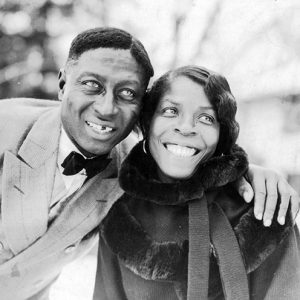calsfoundation@cals.org
The Rock Island Line
“The Rock Island Line” is a world-famous song—recorded by the likes of Johnny Cash, Harry Belafonte, and Grandpa Jones—the earliest known performances of which are two 1934 recordings made in Arkansas prisons. A tall tale in rhyme, the song’s subject is a train so fast that it arrives at its destination in Little Rock (at 8:49) before its departure from Memphis (at “half past nine”).
The collectors responsible for the first recordings were an unlikely pair. John Lomax was a white, Mississippi-born college teacher already well known as a folksong collector, while Huddie Ledbetter was a black, Louisiana-born singer and guitar player just released from prison and soon to be even better known as “Leadbelly.” Arriving in Arkansas in late September and working first in Little Rock (Pulaski County) and then at the Tucker and Cummins prison farms to the south, they recorded two versions of “The Rock Island Line.” Both versions were dominated by the chorus, in call-and-response form. “I say the Rock Island Line,” the leader sings, answered by, “Is a mighty good road” from the group. Three repeats of this are then closed off by the verse’s final lines, sung by all: “If you want to ride, you got to ride it like you’re flyin’ / Buy your ticket at the station on the Rock Island Line.” It was from the beginning a celebration of speed, a hymn to motion itself raised by men who could go nowhere.
In recording the second version, Lomax and Ledbetter encountered, as the song’s leader, their most outstanding Arkansas prison singer, Kelly Pace, a petty criminal from Camden (Ouachita County) who eventually contributed more than thirty performances to the Library of Congress archives. Lomax made additional recording trips to Arkansas prisons in 1939 and 1942, unaccompanied by Ledbetter. Pace was a free man at the time of the 1939 visit, but Lomax collected a third version of “The Rock Island Line,” this time in Cummins Prison. By 1942, Pace was back in prison, sent up for forty-two years for stealing a car, and once again he was the star, performing some twenty-six songs as a soloist or member of a larger group. One of these is a fourth performance of “The Rock Island Line,” the last version collected in Arkansas by Lomax.
Ledbetter was the one who made “The Rock Island Line” famous. He remembered the song from the two 1934 sessions and eventually recorded it many times, first for folksong collectors at the Library of Congress in 1937 and later for commercial labels (RCA Victor in 1940 and Capitol in 1944, among others). Ledbetter’s fame carried several songs into the nation’s folksong repertoire—“Goodnight Irene” and “The Midnight Special” are two other examples—but “The Rock Island Line” became as famous as any.
The train itself shifted its destination to New Orleans, Louisiana, in these later versions, losing its Arkansas references in the process. Then, in 1956, “The Rock Island Line” became a pop music hit when Scottish singer Lonnie Donegan’s version spent twenty-two weeks on the British charts, reaching the No. 8 spot in February. The same version also did well in the United States, spending several weeks in the top twenty and topping out at the No. 9 spot in April.
“The Rock Island Line” remains a staple of the American folk music repertoire, available in scores of performances across a wide range of musical genres. Its Arkansas roots have mostly been forgotten, but Johnny Cash, who had earlier recorded the song for Sun and other labels, performed it at Cummins in 1969, bringing the state’s most famous train back home.
For additional information:
Cochran, Robert. “Ride It Like You’re Flyin’: The Story of ‘The Rock Island Line.’” Arkansas Historical Quarterly 56 (Summer 1997): 201–229.
Cohen, Norm. Long Steel Rail: The Railroad in American Folk Song. Urbana: University of Illinois Press, 1981.
Robert B. Cochran
University of Arkansas
 Arts, Culture, and Entertainment
Arts, Culture, and Entertainment Music and Musicians
Music and Musicians Railroads
Railroads Huddie (Leadbelly) Ledbetter and Martha Ledbetter
Huddie (Leadbelly) Ledbetter and Martha Ledbetter  John Lomax
John Lomax 




Comments
No comments on this entry yet.